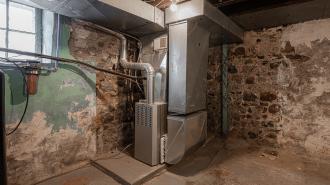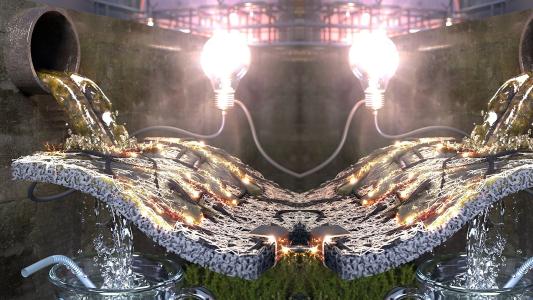In the US, 43% of all the energy consumed in the home is used to keep us warm, and the bulk of this is from natural gas furnaces.
Gas heat has become steadily more efficient over the past decade, under stricter regulations by the Department of Energy.
But as calls to eliminate greenhouse emissions become more and more urgent, researchers are increasingly concerned that we still are off course to meet our climate goals.
The challenge: While the goal of carbon-free heating could one day be reached with electric heaters powered by renewable energy, the logistics required to replace gas heaters entirely will be enormous, and could take years to achieve.
In the meantime, the priority for many researchers is to push the efficiency of gas heaters as far as possible, so we get the most heat with the lowest amount of emissions.
In the US, 43% of all the energy consumed in the home is used to keep us warm, and the bulk of this is from natural gas furnaces.
Today, the best designs available to everyday consumers are “condensing furnaces.” They use secondary heat exchangers to capture and recycle the heat contained in hot exhaust from the furnace – boosting their efficiency to over 90%.
Unfortunately, this impressive performance comes at a cost. Once they condense into liquids, the acidic compounds formed from the combustion of natural gas (including sulphur oxides, nitrogen oxides, and formic acid) unleash harmful gases — including other nitrogen oxides, carbon monoxide, and methane.
These are not only potent greenhouse gases, they’re also bad for human health and can cause immense damage to the environment.
Cleaner air: Researchers at Oak Ridge National Laboratory in Tennessee have now designed an add-on to condensing gas furnaces that they hope could be an easy fix to this problem.
In their study, Zhiming Gao and colleagues introduced an “acidic gas reduction catalyst” — a ceramic cylinder in a metal casing.
The team treated the ceramic with a carefully-adjusted mixture of titanium oxide, copper oxide, and platinum, coating the porous structure inside the cylinder. As the acidic exhaust gases produced by the condensing furnace pass through this ceramic, the researchers predicted several reactions should take place:
Unfortunately, condensing furnaces release potent greenhouse gases that are bad for human health and can cause immense damage to the environment.
While sulphur oxides should become trapped on the porous ceramic surface, nitrogen oxides should split into oxygen and harmless nitrogen gas.
Theoretically, this oxygen should react with the remaining carbon-based compounds to produce carbon dioxide – ironically, this is a better outcome, because it is far less harmful than carbon monoxide, and less potent a greenhouse gas than methane.
Neutron power: To test their predictions, without disrupting the gas passing through their catalyst, Gao’s team used a technique named “neutron computed tomography.”
This involved bombarding 2D slices of the ceramic with neutrons, which can easily penetrate its outer casing.
By detecting the neutrons scattered by atomic nuclei inside the catalyst, the researchers could build up a detailed picture of its interior structure. Then, by stacking the 2D image slices on top of each other, they could build up 3D images of the entire catalyst.
In their experiment, Gao’s team used this technique to measure the distribution of soot inside their catalyst over 4 hours of operation. Soot is created by the incomplete combustion of natural gas – so by measuring the distribution of soot particles, the researchers hoped to gain a reliable picture of how exhaust gases flow through and react with the catalyst.
Just as they predicted, the team’s tomography images showed that the amount of soot deposited inside their catalyst steadily decreased as the exhaust passed through – clearly showing that the acidic gases had reacted with the catalyst and converted into other compounds.
Researchers have now designed an add-on that they hope could be an easy fix to the problem — like a catalytic converter for furnaces.
Retrofitting gas heaters: If this technology could be scaled to commercial gas heaters, Gao and colleagues predict its impact could be just as transformative as catalytic converters for cars. When they were fitted onto exhaust pipes, catalytic converters turned toxic gases into safer compounds, and have likely saved many lives from dangerous air pollution since they were first widely implemented.
The team says their catalyst could not only be manufactured from affordable, widely available materials, it could also be easily retrofitted onto existing condensing furnaces.
Ultimately, if the technology is widely rolled out, the researchers hope it could help bridge the gap between the inefficient and harmful burning of fossil fuels and the entirely carbon-free technologies of the future.
We’d love to hear from you! If you have a comment about this article or if you have a tip for a future Freethink story, please email us at [email protected].






